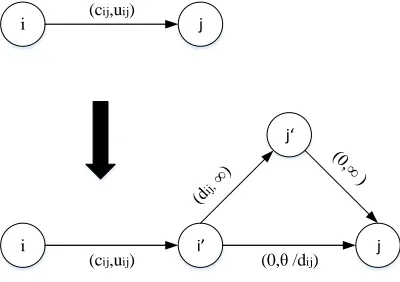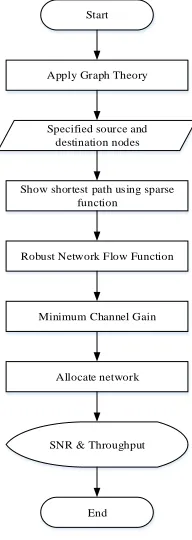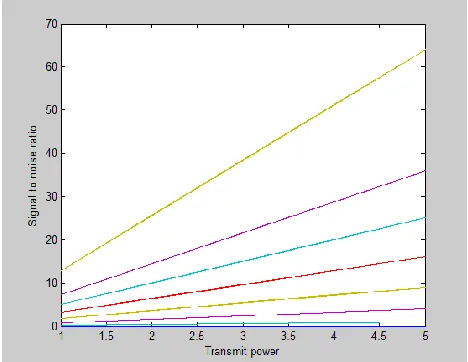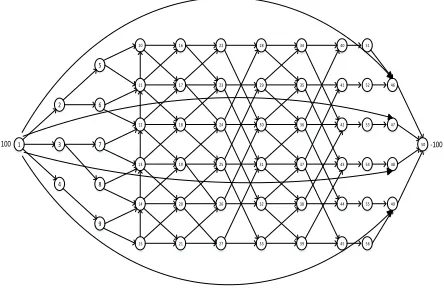369
Design And Planning Of E- Learning
Environment/E-Education System On
Heterogeneous Wireless Network Control System
ThandarOo, HlaMyo Tun
Abstract: The purpose of this research is to provide a more efficient and effective communication method between teacher and student with the use of heterogeneous network. Moreover, the effective use of heterogeneous network can be emphasized. The system of e-education can develop utilizing wireless network.The e-Education system can help students to communicate with their teacher more easily and effectively using a heterogeneous wireless network system. In this wireless network system, students, who are blind or dumb, will also be able to communicate and learn from the teacher as normal students can do. All the devices or laptops will be connected on wireless LAN. Even when the teacher is not around, he will be able to help his students with their study or give instructions easily by using the mobile phone to send text or voice signal. When the teacher sends information to the dumb student, it will be converted into sign language for the student to be able to understand. When the dumb student sends the information to the teacher, it will be converted into text for the teacher to understand. For the blind student, text instructions from the teacher will be converted into audio signal using text-to-speech conversion.Thus, the performance of heterogeneous wireless network model can evaluate by using Robust Optimization Method. Therefore, the e-Education system’s performance improves by evaluating Robust Optimization Method.
Keywords: Heterogeneous Wireless Network, e-Education, Robust Optimization Method, Network Control System ————————————————————
I.
I
NTRODUCTIONTo provide high-speed communications services to several mobile users in a seamless manner, multiple wireless access technologies are integrated to form a heterogeneous network where the users are able to choose between different wireless networks according to their preference, performance and cost. Because of the diverse usage patterns and QoS requirements for wireless data services, the users are able to reduce the costs by exploiting different radio access technologies.A mobile network operator could accomplish a related increase in network capacity in disparate customs in such a way that he could prefer toadvance the air interfaces in cellular systems, to arrange denser (heterogeneous) networks, to lease capacity from specialized (WLAN) network contributors and to split (radio access) transportation with additional operators. In this research, the management of radio source for this integrated heterogeneous wireless network control system will be proposed. At the mobile terminal, an algorithm will be developed to find the most efficient path for transmitting the data which can provide required QoS with least connection cost. An optimal network model will be created to get the optimal decision for intelligent network control system.The essential idea behind this paper is to provide a platform to the students by using heterogeneous wireless network system. The proposed culture and association system, which has been pilot-tested, is expected to provide the best possible e-Learning to community so that they can be confident and situate compact in this humankind and struggle with individuals.
Heterogeneous wireless access networks are today
considered to be a key enabler for affordable wireless access to the internet. While mobile systems hold out high-quality coverage and reliability for low and realistic data rates, Wireless Local Area Network (WLAN) technologies harmonize fixed broadband connectivity with local area experience for higher data rates. Thanks to the diverse usage patterns and quality of service requirements for mobile and wireless data services, operators may reduce their costs significantly by exploiting different radio access technologies.Heterogeneous wireless network are purposed for future wireless access networks because it consists of multiple radio access standards and base stations technologies shaping. To what coverage these preferences are dominated in practice will of course be enclosure unambiguous and ultimately depend on a number of technical, financial, marketing and dictatorial factors. Hence, identifying universal supplies for future systems is a complicated work which is of great significance not only for the operators, but also for equipment retailer. In this research, Robust Optimization in Linear Programmingwas proposed for uncertain demand of minimum channel gain flow. The approach presented in this research is based on a transformation of uncertainty in the supply/demand vector to uncertainty in the gain vector.Many dynamic sub-carrier assignment algorithms have been described in today. Compared to static schemes these dynamic assignment algorithms can provide a performanceincrease of 100% per terminal, simply by utilizingthe given bandwidth and transmit power much better. Inthe latter case each sub-carrier receives an equal amountof transmit power. Together with a target bit error probability the suitable modulation type can be obtained at once. In addition, the total transmit power is limited.
II.
M
ETHODOLOGYThere are many approaches to address data uncertainty in robust optimization method.Robust optimization method can
present a different approach to handle data
uncertainty.Robust optimization method is to find a solution that can cope best with all possible realization of the uncertain data.It is also well-known because it immunes against uncertainty.According to robust optimization method, it is ________________________
ThandarOo, HlaMyo Tun
Department of Electronic Engineering, Mandalay Technological University, Mandalay
called cost.In this thesis, cost is assumed as distance.It is used to be good algorithms more in the system.In robust optimization method, cost efficient and data in the constraints of an integer programming problem are subject to uncertainty. As both cost efficient and data in the constraints of an integer programming problem are subject to uncertainty, robust integer programming problem of moderately large size is proposed.Since only the cost coefficient is subject to uncertainty and the problem is 0-1 discrete optimization problem on n variable, the problem can be calculated by solving at most n+1 instance of the original problem.When only the cost coefficient is subject to uncertainty and the problem is minimum cost flow problem, the feasible solution is captured by solving a collection of minimum cost flow problem in a modified network. In this thesis, it is concerned that robust minimum cost flows can also be solved by explaining a collection of modified nominal minimum cost flows. Given a directed graph G = (N, A), the minimum cost flow can be described as below:
min z(x)= xijcij i,j ∈A
bi= xij
j\i,j ∈A
- xji
j\j,i ∈A
for all i∈ N
0≤xij≤uijfor all (i,j)∈A
It can be assumed that X is a feasible solution and the uncertain cost entry is inserted, the robust minimum cost flow problem is as follow.
Z∗=min c'x+ max
{S\S⊂A,S≤Γ}(i,j)∈S dijxij
Subject to x ∈ X
In this equation, both minimization and maximizing includes. According to equation,
Z∗ = min
θ≥0Z(θ)
Where,
Z θ =Γθ+min c'x+ p
ij (i,j)∈A
Subject to
pij≥dijxij-θ
pij≥0 x∈X
For a fixed θ ≥ 0, the minimum cost flow problem can be calculated by eliminating the variables pij.
Z θ =Γθ+ min c'x+ max[x
ij
-θ dij
,0]
(i,j)∈A
The nominal cost values csj for new arcs are chosen higher than the costs of the longest used path in the basic demand minimum cost flow problem. Nominal cost,
csj = Ibasici+1
Extra cost or the uncertainty cost,
dsj= Ifullmax+3- csj
Possible extra demand for new arc,
usj = -zi
Where zi = the difference from basic demand to full demand.
Let G΄ = (N΄, A΄), be the new directed graph. It can illustrate that explaining a linearminimum cost flow problem with data as above.
i j
i i j
j
(cij,uij)
(cij,uij) (0,θ /dij)
Figure 1. Inserting new nodes and new arcs
For every arc (i,j) ∈ A, two new nodes i΄ and j΄ replace the arc (i,j) with arcs (i, i΄), (i΄, j΄),(j΄, j) and (i΄, j) with the next costs and capacities as shown in Fig.1.
cii΄=cij
uii΄=uij
cj΄j=0
uj΄j=∞
ci΄j=0
ui΄j=θ dij
ci΄j΄=dij
ui΄j΄=∞
371
undirected graph.Directed graph means that there is an ordered pair between nodes, in which the direction of arc (i,j) is not the same the direction of arc (j,i).Otherwise, undirected graph means that there is no ordered pair between arc (i,j) and arc (j,i),where the directions of these arcs are equal. In this paper, when the teacher communicates with his students without any difficulty,shortest path problem with minimum cost can apply. Shortest path problem can be purposed for sending
data to the optimal desired destination in these
heterogeneousnetwork without any difficulty. Dijkstra’s method can be used to solve shortest path problem for e-Learning system.It is easy to adapt it to solve shortest path problems in directed graphs where all the weights are positive. Dijkstra’s formula:
newd[v]=min{d[ v],d[u]+w(u,v)}
d[v]=final path of length (or) new distance
d[u]=initial path of length (or) original distance
w[u,v]=weight of the path (or) distance
pred [v] = u (originally,pred[v]=w)
Color [v]= black (final vertices) & white (initial node)
III. I
MPLEMENTATIONIn this paper, the minimum gain flow problem is used to simulate the uncertain network flow with robustoptimization. The project consists of three main parts, minimum cost network flow simulation, minimum channel gain simulation (transform from cost vector to gain vector), and the signal to noise ratio for maximizing the minimum throughput simulation. The minimum channel gain simulation which is used to compute the minimum channel in heterogeneous wireless network control system. The signal to noise ratio for maximizing the minimum throughput simulation consists of signal to noise ratio and transmitted power. The user can cooperate both with the minimum channel gain flow simulation, and the signal to noise ratio for maximizing the minimum throughput simulation with MATLAB environments. And then allocate 50 nodes randomly by applying Graph Theory.Then, design matrix related with these 50 nodes by graph theory. Network model can be developed these facts.Linear programming can be solved mathematical problem in network. The flowchart of the overview of system is shown in Fig.4.The simulation is realized in MATLAB language by using R2008b.In order to find minimum channel gain flow in uncertain network, simplex algorithm is premeditated in literature. Based on the research of robust optimization on network flow, robust optimization minimum channel gain flow method is specified and mathematical model are created with the wireless minimum channel gain network flow problem. The problem formulation is talented from the equal power distribution and dynamic subcarrier project with heterogeneous wireless network flow. In order to find the shortest path problem and distance (cost) in heterogeneous wireless network, Dijkstra’s method is specified. Then the location of nodes can be expressed on graphic window of the MATLAB. According to the sparse function, the location of each node will be displayed on the monitor.
Text-to-speech conversion
Speech-to-text conversion
Normal Student Blind Student Deaf and Dumb
Student Teacher
(Source Node)
(Destination Node)
Figure 2.Block diagram of e-Education System
Figure 3.Original Network for uncertain demand
Start
Apply Graph Theory
Specified source and destination nodes
Allocate network Show shortest path using sparse
function
End SNR & Throughput Robust Network Flow Function
Minimum Channel Gain
Figure 4.System flowchart
3
1 7
13 19
24
31 37 43
49
2
4 5
6
8
12
14 11
15
10 16 22 28 34 40
17
18
20
21 23
25
26
27 29
30
32
33 35
36
38
39 41
42
44
45 46
47
48
9
(2,30) 100
[50,35]
[15,20]
[15,20]
In this strategy, system is concerned with the features of dynamic subcarrier assignment in combination with equal power distribution per subcarrier.Each subcarrier n is
assigned to at most one terminal j at time t, denoted by𝐛𝐣,𝐧
(𝐭)
set to one.If bj,n(t)is set to zero, n is not assigned to j at t.Equal transmit power occupies each sub-carrier.The adaptive modulation system is practical on top of the dynamic sub-carrier project and eternal power distribution. For the selected goal, this results in an integer programming problem: The instant SNR of subcarrier n for terminal j at time t can be written as
SNR= POWER×ATTENUATION
NOISE POWER
max∈
Subject to bj,n
(t)
j ≤ 1 for all n
I
n
pn(t)vj,n(t) 2
σ2 .bj,n (t)
for all j
Where nI
pn(t)vj,n(t) 2
σ2 describes the number of bits per downlink
phase that can be broadcasted on sub-carrier n for terminal j at time t with transmit power of pn(t) (thus, this function molds
the adaptive modulation structure, depending also on the target SEP).
σ2 =noise power
vj,n(t) 2
=attenuation
The MATLAB function of maximizing the minimumthroughput for power distribution and dynamic subcarrierassignment has two main parts. The SNR and minimum_throughput are calculated by linear integer programming equations. Finally, the maximum function for minimum throughput can be evaluated by numericalcalculationmethod. The channel allocation results forchannel gain can be got by linprog function.
IV. S
IMULATIONR
ESULTSIn this research, three simulations with different settings consist of in orderto test certain features of the simulation. The first simulation was the maximizing the minimum throughput and signal to noise ratio with transmitter imitation. The minimum throughput essentially depends on the channel and allocation. However, if the number of channel is three, the proposed network flow will be displayed. On the second simulation, allocation for the mcnf.m function can be described. Finally, in the third simulation, to check how the incensement of the allocation could affect the maximizing the minimum throughput and signal to noise ratio with transmitter simulation, thus it is used an object in this simulation but it is increased the allocation. The optimal solution of the linear
programming equation have been got from
linprog.mfunction.The signal to noise ratios for the fifty
channel network model are calculated from the
max_min_thrput.m function with respect to the channel allocations and power control flow of the network model. According to the simulation results, the value of maximizing the minimum throughput for 50 Allocations is 6.21dB.The
value of maximizing the SNR is 498.1373.The SNR values curve is shown in Fig.5. From Fig.5, the signal to noise ratio depends only on the transmitted power. If the transmitted power is increased to a certain level of power, the signal to noise ratio will be increased with the appropriated function. According to the results for the 50 allocations for reference
model of network flow, the value of
maximizing_the_minimum_ throughput is matched with the wireless heterogeneous model.
Figure 5.Simulation Result of SNR with respect to Transmitted Power
According to the robust approach, uncertainty in cost vector with minimum cost flow problem is solved in a modified network. New nodes and new arcs are inserted to original network as shown in Fig .6. In this figure, the single source and single sink network can be obtained by inserting new nodes and new arcs.
Figure 6. Result ofextended network model with inserting new nodes and new arcs
After inserting new nodes and arcs, a set of the flow amount xij is reformulated.The resulting values of xij on each arc can
be compared to the values of extra cost on new arcs. If the flow amount xij is greater than the extra cost, xij will not route
on new arcs as can be seen in Fig.7.
3
1 7
13 19
24
31 37 43
49 2
4 5
6
8 12
14 11
15
10 16 22 28 34 40
17
18
20
21 23
25
26
27 29
30
32
33 35
36
38
39 41
42
44
45
46
47
48
9
(2,30) 100
50 54
51
52
53
55
56 60 57
58
59
61
62
(0,15)
373 Figure 7.Result ofrobust network
V. C
ONCLUSIONIn this paper,uncertain demand of the maximizing_the_ minimum_throughput and the value of SNR can evaluate by robust optimization method.Thus, the signal to noise ratio with respect to transmitted power from the two experiments are roughly the same. Finally, we successfully executed the user interaction feature such that the user can insert external parameters and others to the simulation as well as flowing
through the network in heterogeneous wireless
communication.The implementation of minimum cost network flow with robust optimization can be used to simulate network flow in uncertain demand .If the number of allocations is more than 20, the maximizing_the_ minimum_throughput will be low.The shortcoming of the minimum cost network flow with robust optimization simulation can be obtained. The results from MATLAB code can be implemented.According to the simulation results,themaximizing_the_minimum_throughputis 6.21 dB.Maximizing the SNR's value is 498.1373dB. Therefore, the heterogeneous wireless network could interrelate in the mobile communication correctly, such as the source easily connect to the sink of the network flow.
A
CKNOWLEDGMENTThe author would like to thank to Dr.Hla Myo Tun, Associate Professor and Head of the Department of Electronic Engineering, Mandalay Technological University for his help and for his guidance, support and encouragement. In particular, the author would like to thank U Soe MyintOo, my father; Daw May Myat Mon Aung, my mother; Ma NandarOo, my elder sister; and Mg KaungMyat Lynn, my youngest brother; for their complete support.
R
EFERENCES[1] Niebert, N. et al.., ―Ambient networks: an architecture
for communication networks beyond 3G‖, IEEE Wireless Communications Magazine, Vol. 11, No. 2, pp.14–22, 2004.
[2] Klas Johansson and Jens Zander, ―Modelling the cost
of heterogeneous wireless access networks‖, pp 58-66, Int. J. Mobile Network Design and Innovation,.
Vol.12,No.1,2007P.
[3] W. C. Y, Lee, Mobile Communications Design
Fundamentals. New York: Wiley, 1993.r
[4] Hla Myo Tun, and Aye ThandarPhyo, " Integrated WiFi/WiMAX Heterogeneous Wireless Network with Minimum Cost Flow Robust Optimization Uncertain Demand Problem," in Bahria University Journal of
Information and Communication Technology
(BUJICT2010), ISSN 1999-4974, Vol. 3, No. 1, June
2010.o
[5] Hla Myo Tun, and May PhyoMaung, ―Development of
e-Education and e-Health Care System Based on Heterogeneous Wireless Network Control System,‖
[6] Simone Gast, ―Applying Robust Optimization to
Network FlowProblems with uncertain demand,‖
Department of Mathematics,University of Erlangen-N¨urnberg, 2008.
3
1 7
13 19
24
31 37 43
2
4 5
6
8
12
14 11
15
10 16 22 28 34 40
17
18
20
21 23
25
26
27 29
30
32
33 35
36
38
39 41
42
44
45
9
100
54 51
52
53
55
56 48 46
47



